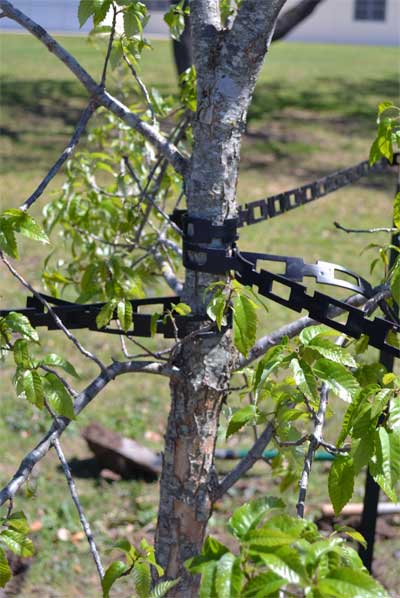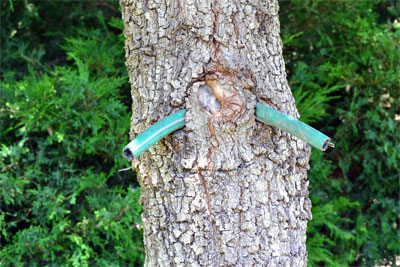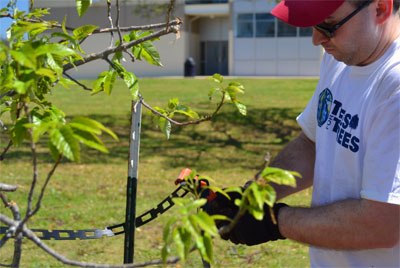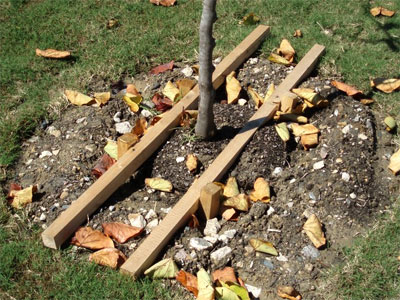Texas Tree Tips

Tree-staking materials have been reinvented, with an emphasis on convenience of installation and improved function. This adjustable black plastic ribbon is easy to install, adjust, and remove when no longer needed. All photos by Bill Seaman.
Stake It — Don’t Break It
As a rule, staking of a new tree is not recommended. When a newly planted tree’s trunk is allowed to sway gently in the wind, root growth is encouraged and the tree develops a strong trunk that has the proper taper from the ground upward. As trees flex in the wind, they build strength in their structure (roots, trunk, and limbs). Furthermore, when staking guy wires remain on the trunk too long, severe injury or loss of the tree can occur. A properly grown and planted tree seldom needs staking. However, there are times when it is both necessary and appropriate.

It is a common practice to use short lengths of garden hose to protect the bark from guy wires. Failure to remove staking materials once the tree is established can result in girdling and, in some cases, the death of the tree.
Trees may need staking if:
- They have a “big head,” or too much top growth without adequate roots and soil to provide support. Having enough roots and soil mass (or root ball) to support the amount of growth above ground is critical. Rule of thumb: Trees need 10 inches of root ball (or containerized roots) for each inch of tree trunk diameter.
- They are planted in finer, lightweight soils as opposed to coarse sandy soils or heavy clay soils.
- They are planted on sites that may have a potential for high winds. These are typically flat, open spaces with few structures or larger trees nearby.
- They are bare-rooted seedlings (trees with no soil on the roots) that are more than 10 to 12 inches tall.
- They are planted around schools or other public areas where there is a greater risk for damage. School and parks officials often state that trees are more likely to be damaged or snapped off if they are too small (under 3 inches diameter) or do not have staking. Stake it or they break it.
- They are in a floodplain area.
- They can be accessed by large animals such as goats, horses, cows, or bulls. Ever see an arborist trying to lasso an angry bull that just trampled some of his trees — using his tree climbing line? It wasn`t pretty, but the bull learned to stay away from the crazy arborist swinging a rope.

Metal tee posts are still the standard for staking large trees. They provide adequate support when driven into the ground outside the planting hole.
There are many methods and various types of equipment that can be used to stake a tree. Some nurseries offer staking kits that include the materials. They may also offer a ground or earth anchoring system.

Securing the root ball is an alternative method of tree staking. Once a few inches of mulch are applied, the staking materials disappear, leaving a neat and clean new tree in the landscape.
Points about staking trees:
- Staking materials must provide the stability and strength necessary for the size of the tree being planted. For smaller trees, less than 2 inches in diameter, a wooden stake driven 12 inches or more into the ground is normally sufficient. Larger trees may require iron tee posts or ground anchors driven deeper in the ground.
- Bare-rooted trees and small saplings may need one to three wooden or bamboo stakes near the trunk for support. However, all other staking should be well outside the planting hole, but not so far out from the hole that it causes a tripping hazard.
- Tee posts are typically set straight into the ground or at an angle away from the trunk. Wooden stakes are typically set at a 45-degree angle.
- Ground anchors are metal with wires on the end that are driven into the ground at an angle. These often come with a turnbuckle to help adjust the tension.
- All stakes and ground anchors present a tripping hazard. An alternative is to use boards or wires across the top of the root ball to hold the tree in place.
- Larger trees, with trunks 6 inches in diameter, for example, may require 2 by 4 lumber near the trunk and driven into the ground for adequate support.
Points about wires and attachments:
- Wire, rope, rubber and other materials can be used, but they must be strong enough to support the force exerted on the tree during a high wind.
- The point of attachment depends on the branching habit and size of the canopy, but should be placed somewhere between one-third and two-thirds of the overall height.
- The point of attachment must not bind or damage the trunk and should accommodate future growth. The idea is to allow some movement and prevent uprooting and to pad the trunk to prevent damage.
- Tension on the material used should be maintained equally on all sides.
Staking should be checked several times a year, especially after a high wind. The time to remove the staking is when you can push against the trunk several times and the roots/soil do not move to any great degree.
If you stake it — it may make it and force you to shake it.
About the author: Steve Houser is a Dallas native with more than 30 years of experience as a consulting arborist and tree climber. He is the president of Arborilogical Services Inc., “The Experts Your Trees Deserve.” www.arborilogical.com.
